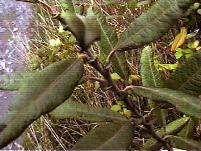

Scouler's Willow
Salix scouleriana
Barratt
ex Hook
var. flavescens
Nutt.
Willow which grows 6-40 feet tall as a shrub or small tree. Twigs are covered with dense velvet. Leaves are deciduous, alternate, 1-4 inches long, narrowly oval, widest above the middle of the leaf, pointed or rounded at the tip, with smooth edges or a few rounded teeth near the tip. Young leaves are densely velvety, while older leaves are dark green and nearly hairless above, and almost hairless or hairy with some rust-colored hairs below. Catkins appear well before the leaves, are 1- 2½ inches long, and are nearly stalkless. Catkins on female plants develop into 3/8 inch-long, narrow, light-brown capsules that mature in early summer. Grows on dry to moist sites in gravelly soils. In upland forests under larger trees and in clearings; also found in wetlands. Full sun to partial shade. Common throughout the Northwest and found in southeastern Idaho.
Medicinal Uses.
A poultice of the inner cambium has been used in the treatment of serious
cuts. A poultice of the damp inner bark has been applied to the skin over a
broken bone. The shredded inner bark has been used as sanitary napkins to 'heal
a woman's insides'. A poultice of the bark and sap has been used in the
treatment of bleeding wounds. A decoction of the roots has been used in the
treatment of dysentery. A decoction of the branches has been taken by women for
several months after giving birth in order to increase the blood flow. The fresh
bark of all members of this genus contains salicin, which probably decomposes
into salicylic acid (closely related to aspirin) in the human body. This is used
as an anodyne and febrifuge. Source
Value for Wildlife:
Scouler willow is an important browse species for wildlife ungulates,
providing critical winter and spring browse. It is often the most preferred
browse in ponderosa pine forests for mule deer, white-tailed deer, elk, bighorn
sheep. Upland sites are heavily used by deer and elk; in riparian areas moose
particularly prefer Scouler willow, especially in winter months. In disturbed
areas, Scouler willow may contribute more moose forage than any other species
present. Scouler willow leaves, twigs, and bark are utilized as browse.
In Idaho, it is preferred elk forage, important in both summer and winter months. Elk use tends to be higher in early rather than late summer. It is also heavily utilized by white-tailed deer and mule deer in Montana and Idaho, predominately as winter forage. Small mammals also browse Scouler willow, and it provides food for grizzly bears.
Upland game birds, ducks, and other birds feed on willow buds, leaves,
twigs, and seeds, and Scouler willow provides nesting and feeding habitat for
small birds. Scouler willow buds provide an important winter food source for
grouse, Clark's nutcracker, and the Rocky Mountain jay. In the early
spring, honey bees use willow pollen and nectar as a source of food for brood
rearing.
Willows may produce dense thickets, making them valuable cover and nesting
habitat for birds and small mammals and providing shade for fish in streams and
ponds. Willows are also valuable for cavity nesting woodpeckers. Scouler willow
provides both visual and thermal cover for deer and elk, and nesting habitat,
cover, and food for non-game birds, upland game birds, and small mammals. In
riparian areas, it provides shade, cooling stream temperatures and providing
escape cover for fish.
(Source)
Planting
Can be grown from seed, but they are very short-lived and must be
planted immediately. Obtain seeds directly from trees, and plant in trays
containing moist sand; sprinkle seeds onto sand, and do not cover them or press
them down. Seeds should germinate in two to five days. Be sure to keep the soil
moist for the first month. Also propagates well from hardwood cuttings,
including live stakes.